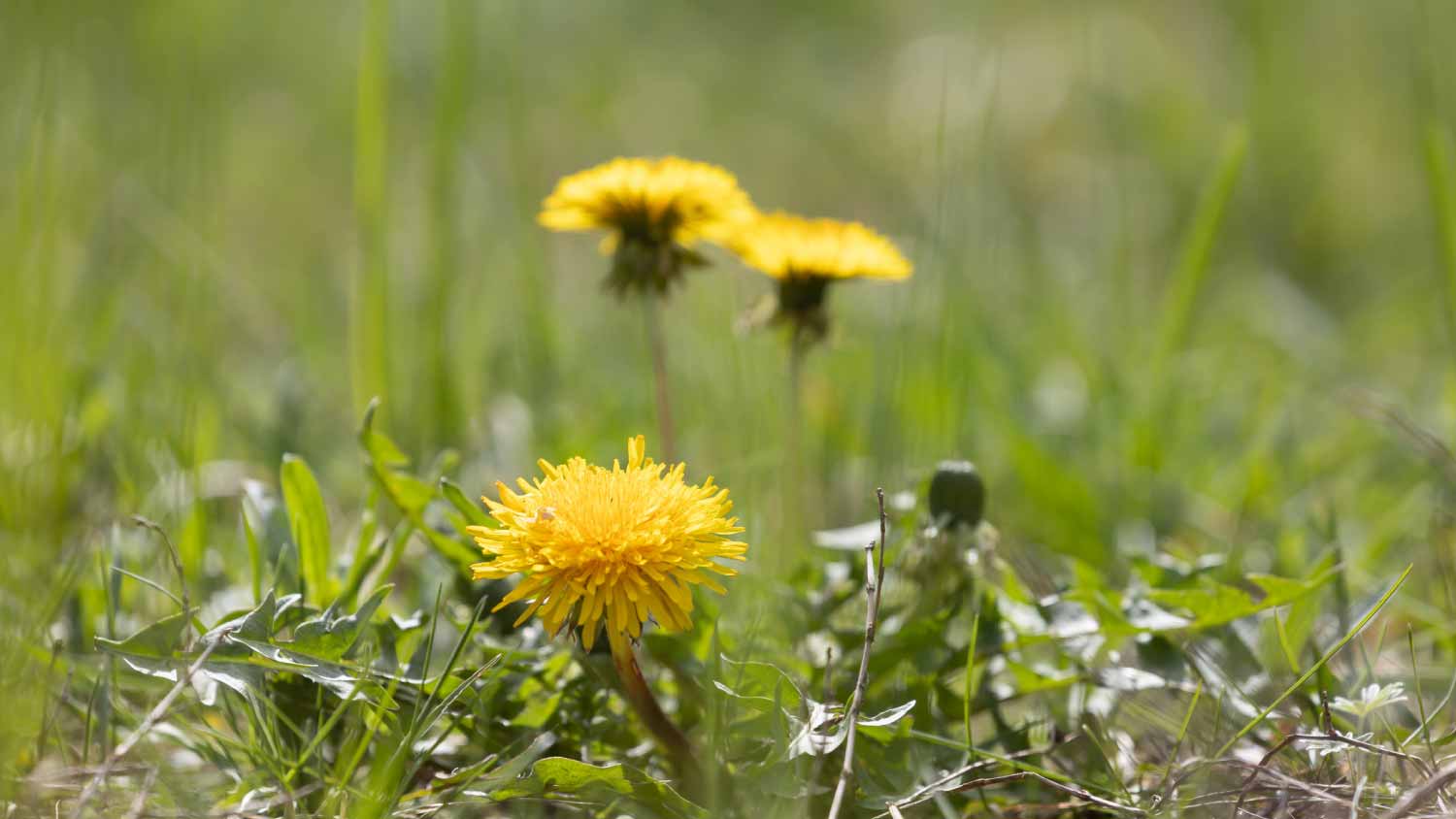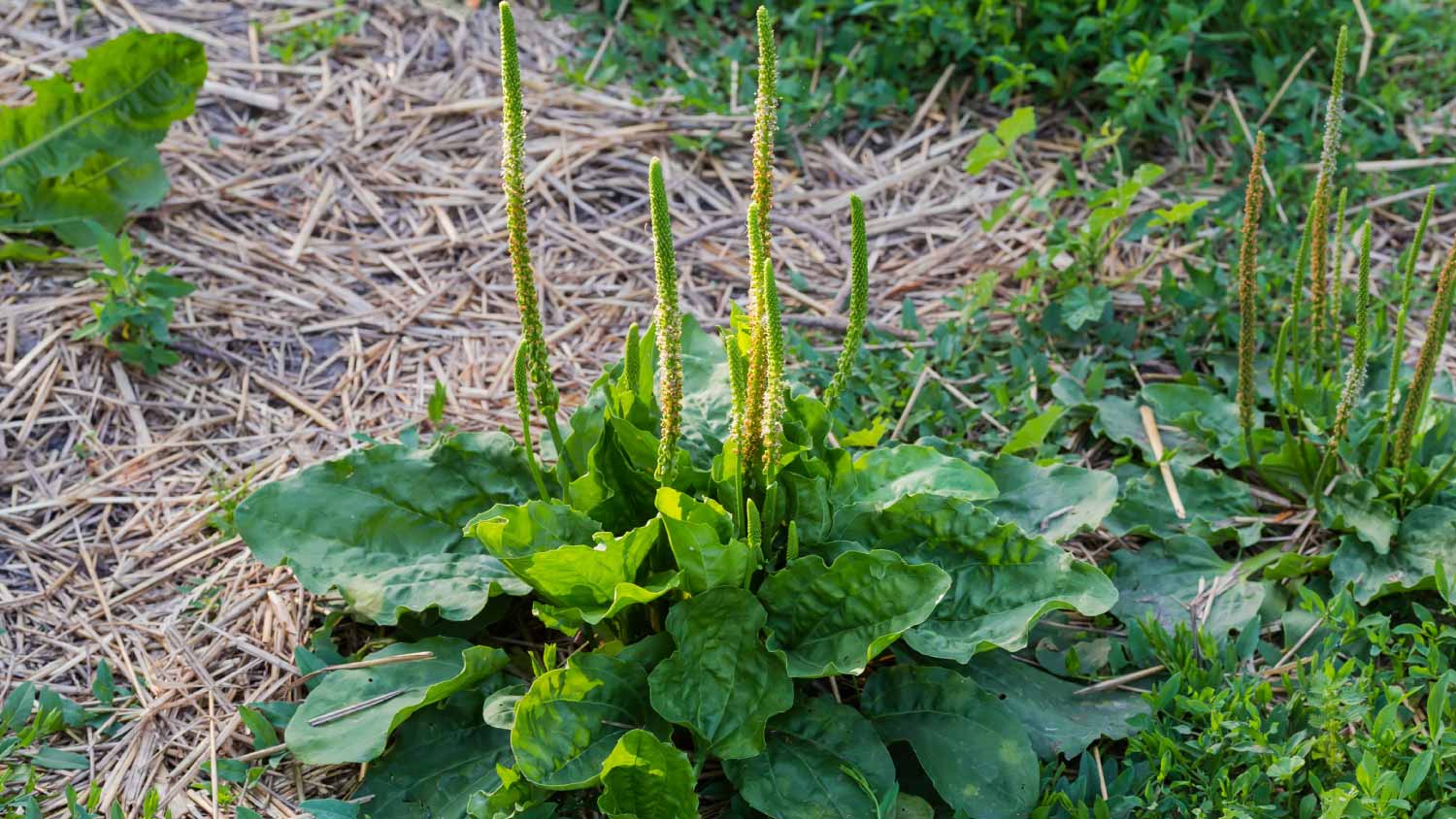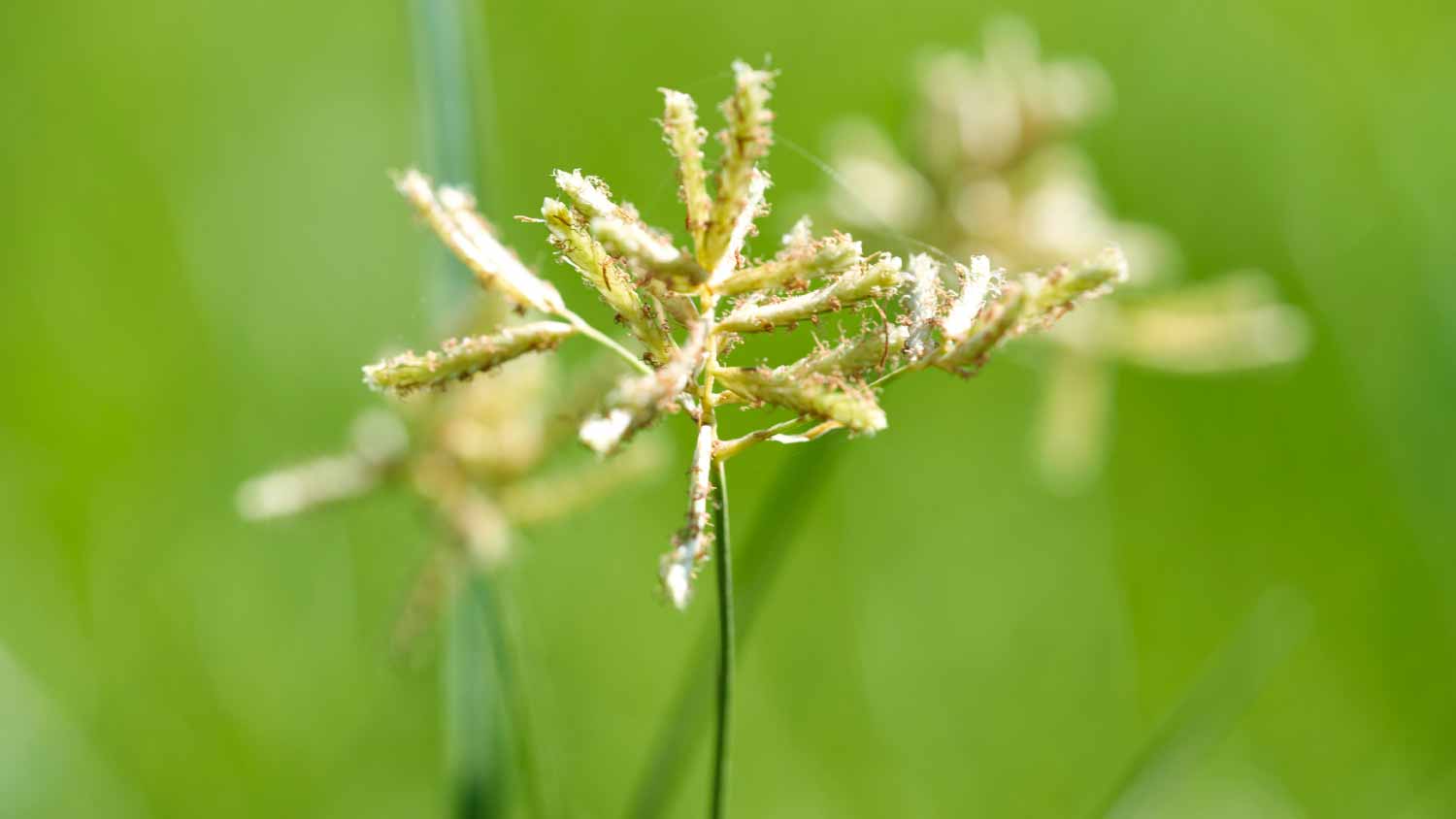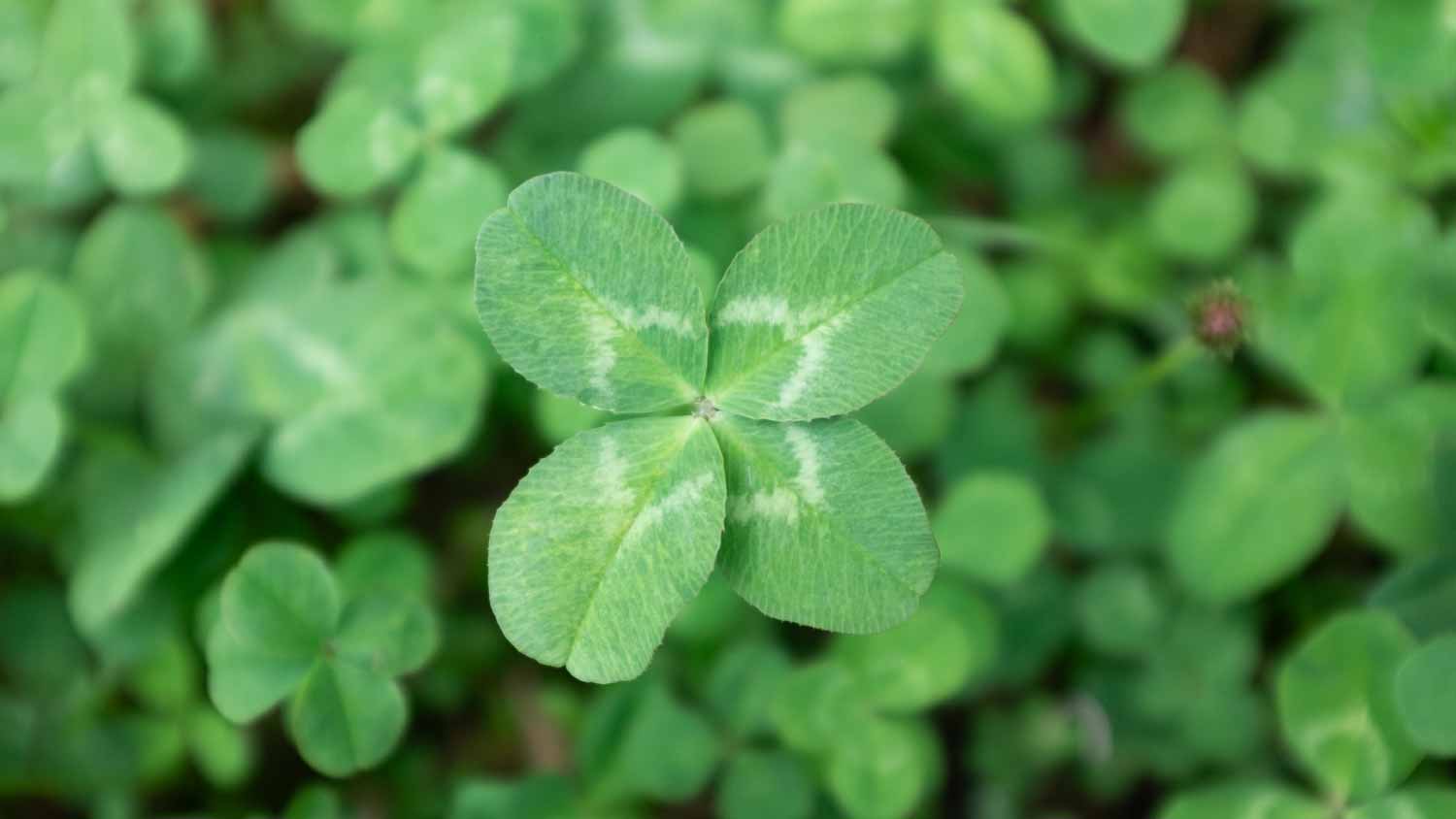9 Types of Weeds in Grass and How to Tackle Them
Tell those weeds to get off your lawn


Weeds are a common pain point for lawn enthusiasts. These noxious lawn invaders can choke out grass and take over, which is why it’s important to learn how to identify the types of weeds in your grass. This guide will cover the most common kinds of grass weeds, how to identify them, and how to control them.

1. Crabgrass (Digitaria)
Crabgrass is a fast-spreading annual weed that thrives in thin or bare patches of lawns. It grows low to the ground and quickly produces seeds, making it difficult to control.
Appearance
Crabgrass has wide, flat leaves that are light green in color and grow outward in a star shape, creating the crab-like look for which it’s named. It also produces seed heads that resemble small spikes or fingers, making it easier to identify during its later growth stages.
Control Methods
The best method for getting rid of crabgrass is prevention. Use a pre-emergent herbicide in early spring to prevent seeds from germinating. You can also pull the weeds by hand if the number is manageable. Keeping your lawn regularly fertilized and well-watered can crowd out crabgrass and reduce its ability to spread.
2. Dandelion (Taraxacum officinale)

Dandelions are among the most notorious types of weeds in grass. They won’t kill grass, but they can spread quickly and interrupt the uniform look of a lush, green lawn. While they have a number of medicinal uses and are edible (provided no herbicides were applied), most lawn owners consider them unsightly and prefer to get rid of dandelions.
Appearance
Dandelions can be easily identified by their fringy yellow flowers and spiky-leafed base. When the flowers are spent, they become white puffballs and eventually shed their seeds into the wind.
Control Methods
The most effective and sustainable way to control dandelions is pulling the plant up completely, including the roots. Broad-leafed herbicides are an option if there are too many to pull up by hand. Keeping grass healthy and mowing it to the correct height will help your lawn flourish so it’s better equipped to outcompete the pesky yellow flowers. Regular visits from a local lawn care professional can help you stay on top of dandelions.
3. Quack grass (Elymus repens)
Quack grass is an aggressive perennial weed that spreads through an extensive network of underground rhizomes. It can quickly invade lawns, often outcompeting for nutrients until the grass dies off. Once established, the thick roots of quackgrass make it difficult to eradicate without persistent intervention.
Appearance
Quack grass is a grass-like weed that grows upright in clusters. It has thin blades that are long and wide, with a bluish-green hue. Its stems are hollow and jointed, and it produces seed heads resembling wheat.
Control Methods
Keeping your lawn healthy and dense by regularly watering, fertilizing, and mowing at the correct height can help prevent quackgrass from taking hold. If quack grass is already established, spot-treat it with herbicides containing glyphosate or dig out the roots completely, ensuring you remove all rhizomes to prevent regrowth.
4. Broadleaf Plantain (Plantago major)

Broadleaf plantain is a common type of weed in grass that tolerates a variety of soil conditions and thrives in compacted or poorly drained soil. It spreads through seeds and forms flat clusters that compete with grass for nutrients and space.
Appearance
Leaves grow out in a low, sprawling rosette shape, with broad, rounded leaves with prominent parallel veins. It produces small greenish flower spikes that extend upward on slender stalks.
Control Methods
Aerating compacted soil and improving lawn health with regular fertilization and overseeding can help prevent broadleaf plantain. For established weeds, hand-pulling or applying a broadleaf herbicide will effectively control it. Ensure you remove the entire root to prevent regrowth.
5. Ground Ivy (Glechoma hederacea)
Also known as “Creeping Charlie,” ground ivy is a low-growing weed that spreads via runners or stolons. Leaves grow in mats and are incredibly difficult to control once they’re established.
Appearance
Ground ivy appears in dense mats of kidney-shaped leaves with scalloped edges. Leaves will give off a minty aroma when crushed. This plant can also grow clusters of tiny blue and purple flowers.
Control Methods
Weeding ground ivy by hand is difficult, as this weed has many roots and spreads aggressively. Any roots that are left behind can spread the plant via the runners. The best time to pull weeds for easier removal is while the soil is moist, ideally after heavy rainfall.
6. Yellow Nutsedge (Cyperus esculentus)

Yellow nutsedge is a grass-like perennial weed. It grows faster than turfgrass and thrives in wet, poorly drained areas.
Appearance
Yellow nutsedge has long triangular stems that are light green with a center vein. It looks very similar to grass, but it is often stiffer and wider. The seed heads are yellow.
Control Methods
To control yellow nutsedge, maintain a healthy lawn by keeping it properly mowed, watered, and fertilized. Manually dig out small patches or use postemergence herbicides when the plant is actively growing. Most common grass herbicides will not be effective—you’ll need to use a nutsedge-specific herbicide, such as halosulfuron. Lastly, be sure to correct any draining issues with your lawn, as this weed thrives in chronically damp soil.
7. Canada Thistle (Cirsium arvense)
Canada thistle is a persistent perennial weed that spreads aggressively through its creeping root system and airborne seeds. Its sharp spines and deep root network make it difficult to control, especially in established lawns.
Appearance
Canada thistle features lance-shaped leaves with sharp, spiny edges. Its stems are slender, and the weed produces small, purple, or pink flower heads that resemble pom-poms. The flowers often bloom in clusters, and the plant can grow up to 5 feet tall.
Control Methods
Mowing regularly can prevent Canada thistle from flowering and setting seed, though this alone won’t eradicate it due to its extensive root system. Use selective herbicides containing clopyralid or aminopyralid to kill the weed without harming grass. For small infestations, dig out the plants, ensuring you remove all roots to prevent regrowth.
8. Clover (Trifolium repens)

Another extremely recognizable weed in grass is the ever-present clover. Growing in dense and widespread carpets, this weed is sometimes used as a low-maintenance lawn alternative. However, those who prefer turf grass typically aren’t a fan of the aesthetic.
Appearance
A popular symbol of St. Patrick’s Day, clovers have three or four rounded heart-shaped leaves, often featuring a faint white crescent pattern. This weed can also sprout long-stemmed pink or white flowers with a dense covering of thin, curved petals that form a lotus-like shape.
Control Methods
To control clover, apply a nitrogen-rich fertilizer to improve lawn health and outcompete the weed. Spot-treat small patches with selective herbicides designed for broadleaf weeds. Regular mowing at the correct height and aerating compacted soil will also discourage clover from spreading.
9. Zoysia Grass (Zoysia japonica)
Sometimes used as a turf grass, especially in poor soil conditions where most grasses won’t grow, Zoysia grass is known for its hardiness and drought tolerance. However, Zoysia spreads aggressively through stolons and rhizomes, making it an extremely invasive plant if it grows in other types of turfgrass.
Appearance
Zoysia grass is a dense, fine to medium-textured turfgrass with a rich green hue. However, it turns brown quickly in cooler temperatures, leaving lawns looking dormant or unsightly for extended periods during fall and winter.
Control Methods
To prevent the aggressive spread of Zoysia grass, add physical barriers around flower beds and neighboring lawns, as its stolons and rhizomes allow it to invade unwanted areas. Regular dethatching is essential to keep your desired turfgrass healthy and able to outcompete Zoysia grass. Removing Zoysia once it’s established can be challenging, but combining manual removal with targeted herbicides is the best plan of attack.













